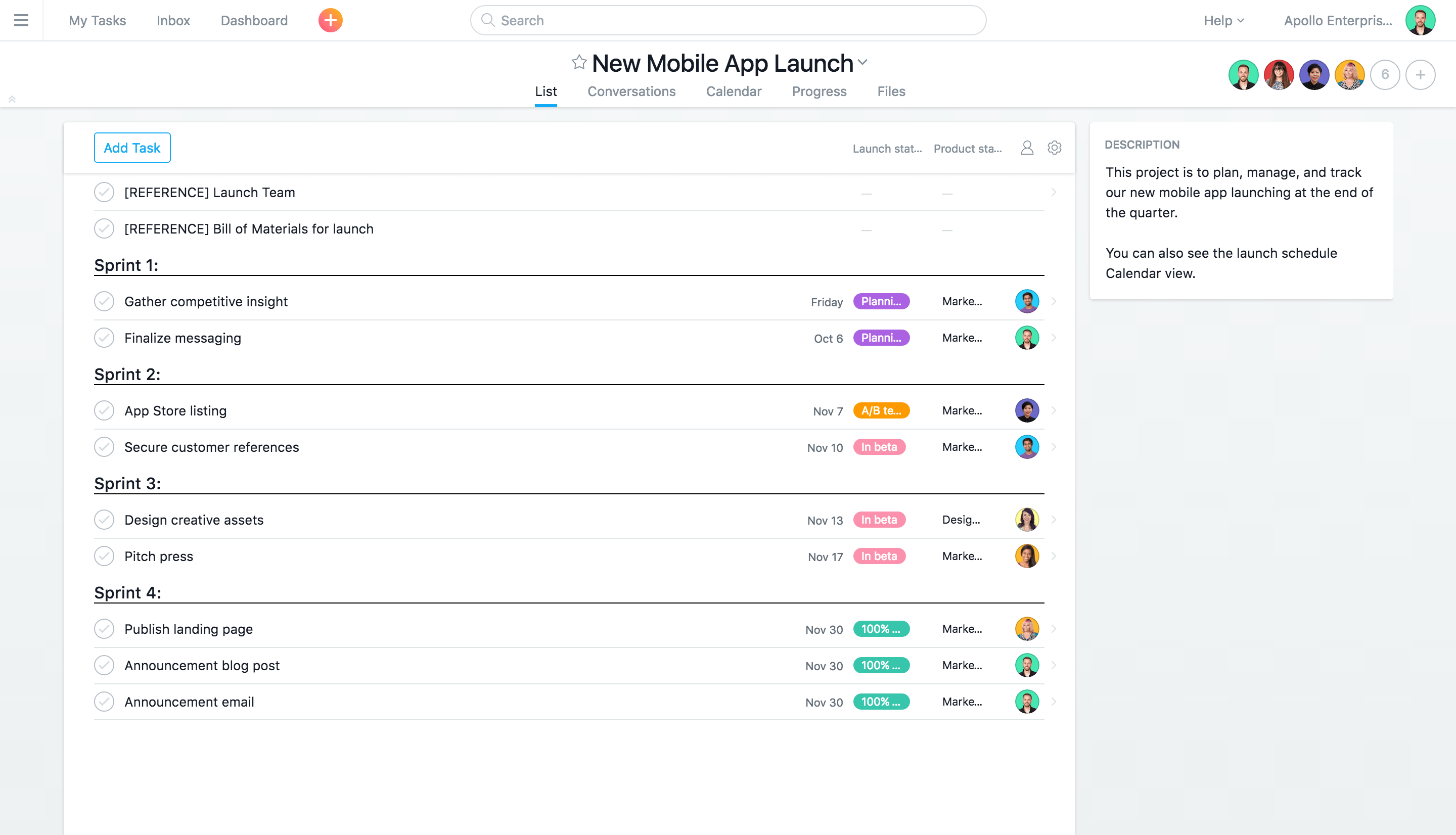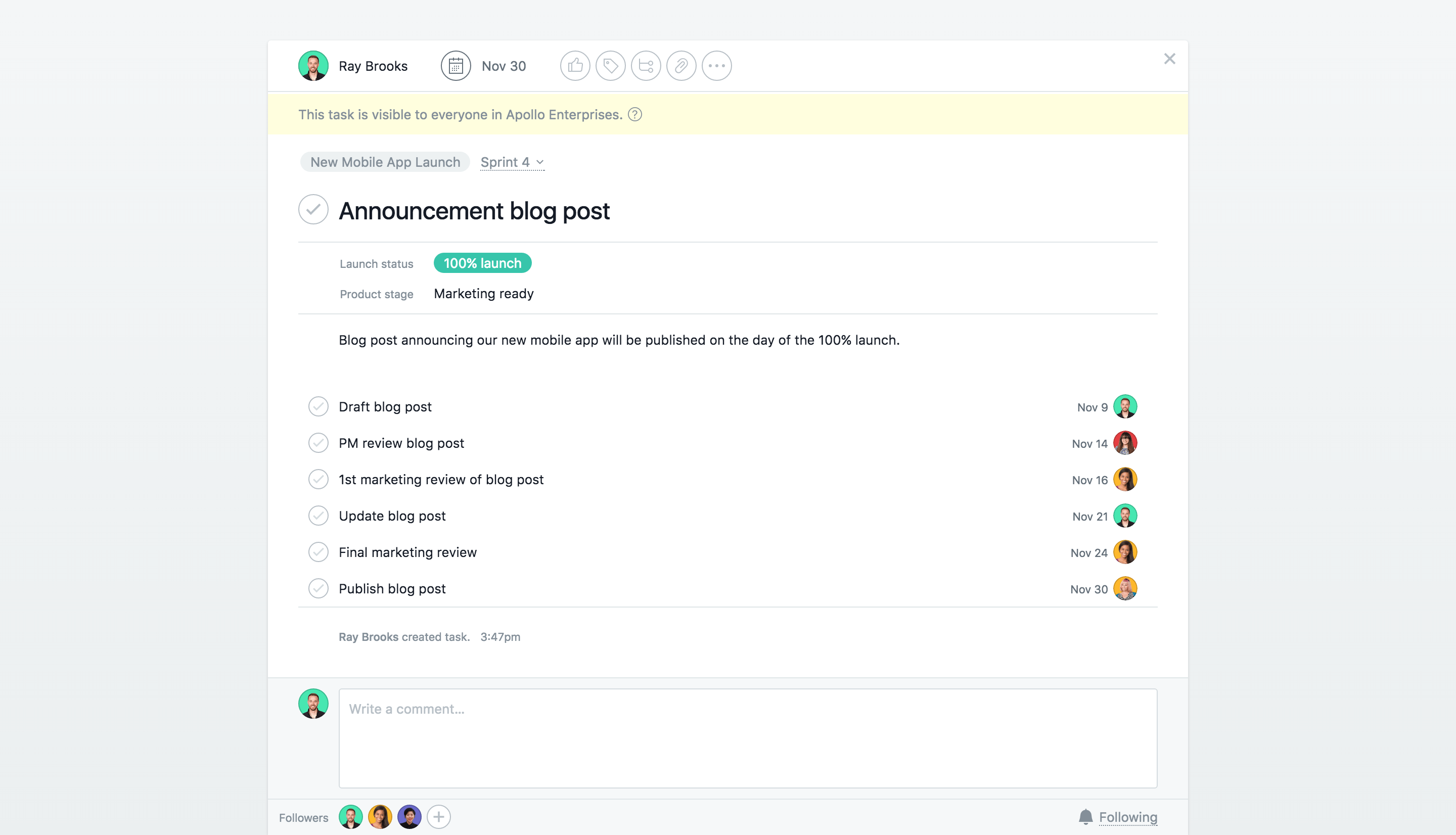Ready for blast off: 5 steps to successfully managing product launches

It takes a lot of work to get your new products in front of your target audience, and even more to get them to try or buy them. Whether you’re working on a small feature update or an entirely new product line, multiple teams are usually involved in the product launch. It can be a struggle to keep everyone on the same page as milestones, timelines, and tactics constantly change.
So, what’s the key to a successful launch? Having a solid process in place. Here are our top five steps for creating a foolproof launch process that helps you bring products to market successfully—every single time.
Want to learn how to run your other marketing programs successfully? Get your free guide on how to create effective processes that turn your marketing strategy into results.
1. Create a central place for cross-functional collaboration
You need a single source of truth for your launch that’s accessible and used by everyone—marketing, product, design, engineering, sales, customer support, and any other team involved in the launch. This ensures that everyone has the same information about the scope, status, and deliverables of the launch.
In this central place, such as a project in Asana, include the launch plan, messaging doc, responsibilities, deadlines, and any supporting assets so it’s clear who’s working on what, the right people can weigh in, and everyone’s on the same page. You’ll get fewer questions about basic launch details and won’t have to manually update numerous places with the same info—talk about saving time.

While work for the launch happens in different tools such as Google Docs, InVision, design software, etc., make sure everything is linked or attached in one central place. This way, team members can find the information they need and are working off the same versions of launch files. And because everyone is aligned on messaging and content across teams, you can feel confident that your customers will have a consistent experience across launch touchpoints.
2. Standardize your launch checklist, but make it flexible
Next, create a standard checklist or process that can be used for every launch—no matter how big or small. Because there’s work you have to do no matter what you’re launching, like craft messaging and notify internal teams, starting with a checklist you can turn into a template will help you avoid wasting time trying to remember every little step.
“Before Asana, we were averaging about three launches a year. Now, we’re launching something every month. Asana is helping us launch 4x faster.”
– Lauren Nguyen, Head of Product Marketing at Pantheon
By starting with a template, all of the steps will already be laid out for you so you can spend your time crafting a compelling story and assets that are unique to the product you’re launching—and appealing to your customers. Plus, product managers and teammates will know what to expect and feel confident work won’t slip through the cracks—no matter who is leading the launch. Here’s how to turn your product launch checklist into a template:
Outline the work that happens in every launch
Your last launch plan is a good place to start. Include everything—milestones, docs, assets, approvals, trainings, and other materials—so you have a complete list. For example, your product launch checklist might include:
- Gather competitive insight
- Host a launch kick-off meeting
- Write and finalize positioning and messaging
- Secure customer references
- Pitch the launch to press
- Write copy for marketing assets
- Design marketing assets
- Publish marketing assets
- Announce launch to current customers
Add structure
Organize the work in the order it needs to happen and add dependencies so teammates can see how their work connects.
Make it flexible
You don’t need to execute each step in your template for every launch, but it should be comprehensive enough to work for launches of any size.
Iterate as you learn
Make small tweaks to the process based on new learnings, so you don’t make the same mistake twice.

3. Set up a clear communication process
Now that you’ve created a source of truth for your launch and standardized the process, let’s talk about communication. Good communication is the unsung hero of a successful launch. But it’s so much easier said than done. Here are some ways to improve it, so no one is left in the dark:
- Build regular check-ins into your launch process: Whether it’s a weekly 15-minute stand-up or a recurring meeting, maintaining regular communication is just as important as outlining which launch assets need to be created. Treat check-ins like any other task that needs to be done.
- Make it easy for product managers to share information with you: Set up clear lines of communication with your product team and map out how to best share updates with one another, so everyone gets the info they need.
- Keep communication centralized: You know how you’re managing and tracking all work for the launch in one tool? Communication should happen there as well so conversations stay in context with the work being done.
- Provide consistent status updates: Especially once you’re 6-8 weeks out, keeping everyone updated on what’s done, in progress, and at risk will help the team prioritize their work so you can launch on time.
4. Add (extra) time for approvals into your timeline
When the approval process spirals out of control, it’s usually because approvers don’t have enough context on why certain decisions were made. This lack of context can significantly delay approvals and potentially derail your entire launch.
To make approvals smoother, outline the approval process before you start. Identify the steps in your plan that will require approval and allocate enough time for getting sign-off on them (for example, the launch marketing plan, messaging and positioning, launch announcement, and anything else that might need approval). Next, identify who needs to approve what so you’re not going in circles forever.
Once work is underway, ask for feedback as you go. This way you can pivot early if you need to and approvers will better understand the reasons behind any decisions your team made. Finally, keep the approval process connected to your work so everyone has the context needed to provide actionable feedback.

5. Work doesn’t end once the product launches
Once your product is out in the market, the hard work may be over, but you haven’t crossed the finish line just yet. It’s important to share the results (wins, learnings, and opportunities) of the launch with your team. This step is often forgotten or skipped because of lack of time, but it helps teammates understand the impact of their work.
And while product marketers hope every launch is successful, sometimes a piece (or all) of the launch misses the mark. Taking the time to produce a thorough recap and summary of results will provide important context and an analysis of the “why” behind your successes (and any shortcomings) so you can use these key learnings to improve your next launch.
Plan, execute, launch, learn, repeat
Launching products, whether net new or seemingly small updates to existing features, can feel like a never-ending cycle. Once you’re done with one, it’s on to the next. By standardizing your process and keeping all your work and communication centralized, you’ll be able to launch products more efficiently and effectively.

